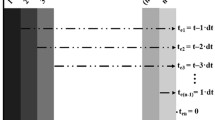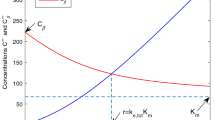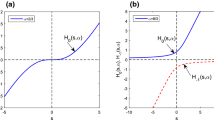Summary
A lag time may exist between blood drug concentration and drug effect. Various factors can contribute to the lag time, among which the drug distribution delay is a significant one. The drug distribution delay can also exist between different compartments. An equation was derived to calculate the steady-state drug concentration delay between central and peripheral compartments in a two-compartment model with infusion regimen.
Similar content being viewed by others

References
Levy G. (1994): Mechaism-based pharmacodynamic modeling. Clin. Pharmacol. Ther. 56, 256–258.
Chiou W.L. (1989): The phenomenon and rational of marked dependence of drug concentration on blood sampling site: Implications in pharmacokinetics, pharmacodynamics, toxicology and therapeutics (Part I). Clin. Pharmacokinet. 17, 175–199.
Chiou W.L. (1989): The phenomenon and rational of marked dependence of drug concentration on blood sampling site: Implications in pharmacokinetics, pharmacodynamics, toxicology and therapeutics (Part II). Clin. Pharmacokinet. 17, 275–290.
Pedraz J.L., Calvo B., Smithers J.A., Thompson G.A. (1992): Pharmacokinetic-pharmacodynamic modeling: Time dependent protein binding_an alternative interpretation of clockwise and counterclockwise hysteresis. J. Pharm. Sci. 81, 232–236.
Mehvar R. (1992): Stereochemical considerations in pharmacodynamic modeling of chiral drugs. J. Pharm. Sci. 81, 199–200.
Gupta S.K., Hwang S.S., Benet L.Z., Gumbleton M. (1993): Interpretation and utilization of effect and concentration data collected with an in-vivo pharmacokinetic and in-vitro pharmacodynamic study design. Pharm. Res. 10, 889–894.
Holford N.H.G., Sheiner L.B. (1981): Understanding the dose-effect relationship: clinical application of pharmacokinetic-pharmacodynamic models. Clin. Pharmacokinet. 6, 429–453.
Abbott Laboratories. Abbottbase Pharmacokinetic Systems. Abbott Park, IL. (1992).
Wu G. (1996): Fit fluctuating blood drug concentration: a beginner’s first note. Pharmacol. Res. 33, 379–383.
Wu G. (1997): An explanation for failure to predict cyclosporine area under the curve using a limited sampling strategy: a beginner’s second note. Pharmacol. Res. 35, 547–552.
Wu G. (1997): Using a four-compartment closed model to describe inhalation of vaporised ethanol on 1–14C-pyruvate kinetics in mice. Arch. Toxocol. 71, 501–507.
Wu G. (1997): Use of a five-compartment closed model to describe the effects of ethanol inhalation on the transport and elimination of injected pyruvate in the rat. Alcohol. Alcohol. 32, 555–561.
Wu G. (1998): Effect of vaporized ethanol on [1-14C] pyruvate kinetics in mice using a four-compartment closed model. Pharmacol. Res. 37, 49–55.
Wu G. (1998): Assessment of glomerular filtration rate by means of the three-compartment closed model after a single intravenous injection. Arch. Ital. Urol. Androl. 70, 7–10.
Wu G. (1998): Estimation of drug excretion from blood into gut using a three-compartment closed model. Pharmacol. Res. 37, 157–163.
Wu G. (1998): Assessment of glomerular filtration rate by means of the four-, and more compartmental closed models after a single intravenous injection. Arch. Ital. Urol. Androl. 70, 51–55.
Wu G. (1998): Using three-, four- and n-compartment closed model to estimate glomerular filtration rate during and after a constant rate intravenous infusion. Eur. J. Pharm. Biopharm. 46, 397–402.
Wu G. (1999): Ethanol inhalation on 1-[14C]-pyruvate kinetics in mice using a six-compartment closed model. Eur. J. Drug Metab. Pharmacokinet. 24, 113–119.
Wu G. (2000): Sensitivity analysis of pharmacokinetic parameters in one-compartment models. Pharmacol. Res. 41, 445–453.
Wu G. (2001): Sensitivity analysis of pharmacodynamic parameters in pharmacodynamic models. Eur. J. Drug Metab. Pharmacokinet. 26, 59–63.
Wu G. (2002): Squared correlation coefficient of measured values versus predicted values in linear and monoexponential regressions. Eur. J. Drug Metab. Pharmacokinet 27, 113, 0117.
Notari R.E. (1987): Biopharmaceutics and clinical pharmacokinetics. 4th edn, New York and Basel: Marcel Dekker, Inc., 222–272.
Tolstov G.P. (1976): Fourier series. Dover Publications, Inc, New York.
Carson E.R., Cobelli C., Finkelstein L. (1983): The mathematical modeling of metabolic and endocrine systems: model formulation, identification, and validation. New York: John Wiley & Sons.
Segre G. (1968): Kinetics of interaction between drugs and biological systems. Il Farmaco 23: 907–918.
Redheffer R. (1991): Differential equations: theory and applications. Boston: Jones and Bartlett Publishers.
Courant R. (1988): Differential and integral calculus. 2nd edn, New York: Wiley interscience Publishers, vol. 2, 438–442.
Edwards Jr. C.H., Penney D.E. (1989): Elementary differential equations with applications. 2nd edn, New Jersey: Prentice Hall.
Birkhoff G., Rota G.C. (1969): Ordinary differential equations. 2nd edn, Massachusetts, Waltham: Blaisdell Publishing Co.
Spiegel M.R. (1974): Theory and problems of advanced calculus. Schaum’s uotline series. McGraw-Hill Book Company, New York, 83–84.
Desoer C.A., Kuh E.S. (1969): Basic circuit theory. New York, McGraw-Hill Book Company.
Calahan D.A., Macnee A.B., McMahon E.L. (1974): Introduction to modern circuit analysis. Holt, Rinehart & Winston, Inc.
Scott R.E. (1960): Linear circuits. Massachusetts: Addison-Wesley.
Huelsman L.P. (1972): Basic circuit theory with digit computations. New Jersey: Prentice-Hall, Inc.
Peusner L. (1970): Ph. D. Thesis. “The principles of network thermodynamics.” Massachusetts: Harvard University.
Wu G. (1992): Ph.D. Thesis: “Modelling of pharmacokinetic process using theory of electrical circuit.” Moscow: Russian State Medical University (in Russian).
Thakker K.M. (1984): Pharmacokinetic-pharmacodynamic modeling and simulation using the electrical circuit simulation program SPICE2. Biopharm. Drug Dispos. 5, 315–333.
Oken D.E., Thomas S.R., Mikulecky D.C. (1981): A network thermodynamic model of glomerular dynamics: application in the rat. Kidney Int. 19, 359–373.
Author information
Authors and Affiliations
Rights and permissions
About this article
Cite this article
Wu, G. Calculation of steady-state distribution delay between central and peripheral compartments in two-compartment models with infusion regimen. Eur. J. Drug Metab. Pharmacokinet. 27, 259–264 (2002). https://doi.org/10.1007/BF03192336
Received:
Issue Date:
DOI: https://doi.org/10.1007/BF03192336



